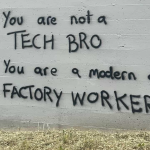It would then be up to the designer and their team to decide whether to make it more difficult to unsubscribe or find ways to convince the user to stay. By focusing only on a small aspect of the system, the designer becomes alienated from the overall product experience.
The internet revolution also resulted in a digital environment where products are no longer stand-alone entities but part of a big ecosystem. Thus, product teams have to deal with forces outside of their own product and company.
An app has to be listed in the app store and is, therefore, obliged to follow specific design guidelines. Apps also use external payment providers (Paypal, Stripe, iDeal), login features (Facebook, Google), data-processing systems (Tableau, Power BI), front-end libraries (Material design, Ant), and user behaviour capturing tools (Google Analytics, Hotjar, Useberry), all of which have additional requirements. Therefore, another layer of a lack of control over the product is added.
Another issue in an Agile environment is that designers can spend more time interviewing the people who give them the assignments (customers) than the users (clients).
“When integrating UX methods in Agile, companies risk focusing more on customers than users.” — Source
Companies might organise planning or knowledge-sharing events to help teams understand what other teams are working on, but this is not enough to reduce alienation.
In pre-capitalist times, the worker could choose which tools to use, when to work, and decide the order of tasks. The introduction of the assembly line ended this freedom.
Flexibility is essential for an independent worker. Making quick decisions based on daily experiences is a key part of the work process.
Fatigue, inspiration, family situations, and seasons influence the worker’s day. In a capitalist society, labour becomes monotonous and repetitive because the tasks of a single worker influence the other workers and the production cycle.
“Individual craftsmen (and, to a lesser extent, women) had a degree of control over their work and could take pride in what they produced, under capitalism, work simply becomes a chore.”
Labour automation makes people operate like robots, or in Marx’s words, animals. If someone can’t control their own actions, they are not free.
“Freedom is autonomy, where an activity is (fully) autonomous if and only if it is an unqualified expression of its agent’s will. In particular, it is autonomous only if it is an expression of her will rather than someone else’s.”
The harmonisation of design
The maturation of the tech industry also required harmonising design and development methods and making workers less flexible and impulsive.
The 1990s webmasters handled the system’s graphic design, functional design, and backend coding themselves. They didn’t follow design tool conventions, UI interaction patterns, or programming guidelines. The independent tech worker was reasonably free in making choices. The main restrictions arose from global technical constraints, such as internet speed and the limitations of HTML and coding languages.
Today, mature Agile organisations dictate how designers work. Companies define the software (Figma, Adobe XD) that a designer must use and how the tool needs to be utilised (name your symbols!). This harmonisation is required for a smooth handover between designers and programmers.
Following industry standards can be exceptionally valuable to designers because it makes them more hireable by other companies.
Something that causes huge frustration among designers and engineers is the mandatory Agile ceremonies.
In a 2-week sprint, designers often have a sprint planning, a sprint review, a backlock grooming session, and a retrospective. This is of course in addition to daily stand-ups.
Likewise, designers might have co-designing sessions or design critique meetings. In addition to these regular meetings, planned for every sprint, designers might have meetings with their customers and users and may attend or host workshops.
This overload of meetings not only frustrates the designer but also compromises design work.
“Professionals seldom pick a UX method not fitting into a Sprint. These strict deadlines make it impossible to follow an open approach that can be reiterated until enough information is gathered as in qualitative research, reducing the UX method’s quality.” — source
UX Designers often describe themselves as introverted, impulsive people. I am personally absolutely one of them. Simply surviving the workweek with an abundance of meetings can be challenging. It might make it difficult to have any energy left for what a designer considers the core of their work: designing.
The worker has lost complete control over their schedule and choices.
“Some teams may feel a lack of autonomy when certain decisions … could not be made by themselves. … The teams did not have freedom to choose which features to build. They had been decided in pre-planning meetings.”— source
The UX designer doesn’t have control over their workday. The UX designer is alienated from the labour process.
Marx also recognises the disconnection from one’s human nature as a distinct form of alienation.
When people follow their human nature, they want to develop their creativity and productivity. The old craftsman was always focused on innovation and improvement, both in himself and his product. Yet, in a capitalist world, work became a commodity that can be bought and sold. A worker thus lost a sense of his own abilities, of his spiritual essence.
The worker no longer pursues their natural impulses but simply follows the tasks assigned by the capitalist. As a result, a person can lose their sense of identity and may feel disconnected from themselves.
“The worker therefore only feels himself outside his work, and in his work feels outside himself.”
Designers are experiment preparers
The word design implies creativity, freedom, and exploration. The role of UX design is often misunderstood and differs greatly from people’s typical associations with design. Many designers have enormous potential. However, their roles and the sub-products they work on are so small that there is little room to utilise the very skillset they desire to grow.
A designer needs to stay in their team’s lane and usually follow the company’s design system. These systems define the artistic, structural, and linguistic criteria that all the company’s output must follow. A designer can exclusively pick from a set of given components to build a UI, similar to assembling an Ikea kitchen.
A designer for McDonald’s can’t suddenly use pink or purple in their app. A designer for a news website shouldn’t distort the visual grid of news articles and ads. A designer for a tax declaration system shouldn’t use jolly language. The design system must be respected.



